THE ALCHEMIST
The opening chapters of Paulo Coelho´s internationally bestselling book The Alchemist are set in Tarifa. The allegorical novel follows the story of an Andalusian shepherd boy who travels to the Egyptian pyramids after a fortune teller suggests that a recurring dream of his indicates he will find treasure there. First published in 1988, the book has become a classic all over the world, having been translated into 70 languages by 2016.
The novel´s protagonist, shepherd boy Santiago, describes Tarifa in terms of both its historical architecture, and its mystical sense of being so close to Africa – which, indeed, triggers the central plot of his journey to Egypt:
Tarifa - built in the Moorish style, set in subtropical gardens leading down to the unspoilt beach.
Stylish & contemporary hotel close to unspoilt beaches. Gardens and large pool. Ideal for families.
Fast 45 min Ferry service, Tarifa to Tanger Ville, choice of two operators. Ideal for exploring Tanger town including day trips. Choose Algeciras to Tanger Med for road trip south in Morocco.
“As he walked past the city's castle, he interrupted his return, and climbed the stone ramp that led to the top of the wall. From there, he could see Africa in the distance. Someone had once told him that it was from there that the Moors had come, to occupy all of Spain. He could see almost the entire city from where he sat, including the plaza where he had talked with the old man.”
He goes on to describe the hot, strong Levante winds which are so famous in colloquial terms in Tarifa; “The wind began to pick up. He knew that wind: people called it the levanter, because on it the Moors had come from the Levant at the eastern end of the Mediterranean.” Even today the difference between easterly Levante and westerly Poniente winds affects beachgoers´ and kitesurfers´ experience of Tarifa.
The book is set in an indistinct pre-modern period, probably in the first half of the 20th century; it is fascinating to see how Coehlo imagines that Tarifa´s otherworldly sense of being the gateway between continents was felt even then. Now, the surfing scene in the town and surrounding area might be more significant, but the Moorish influence on the architecture and culture of Andalucia remains apparent. Visitors to the Cadiz province should make a trip to Tarifa, to stand as Santiago does and take in the striking vista where the Mediterranean and Atlantic, and Europe and Africa, collide.


